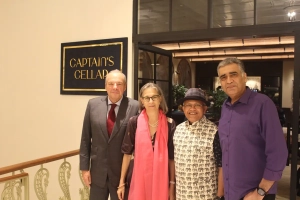From Archives 2008: India World Player in 50 Years
‘Today, the Indian wine industry is still in its infancy; however technology exchange in winemaking and viticulture from Europe and Australasia means India is likely to challenge the supremacy of traditional winemaking countries.
Local demand and aggressive promotion from the state government means more and more ambitious Indians are turning to fine wine as a mark of social standing.
If the increasing number of vineyards planted in parts of western and southern India are any indication, India will soon be taken seriously as a fine wine-growing nation.
India has the potential to embrace wine in a big way and the economic muscle to dictate to producers what style of wine they should be making.’
These are excerpts from Berry Bros. & Rudd ‘Future of Wine Report’ that crystal gazes into the wonderful world of wine, 50 years hence, in 2058.
Here is something for the doubting Thomases who believe Indian wines have poor quality. In 1958, few people would have predicted that the USA, Argentina or Chile would be capable of producing good wine. Today, these countries lead the New World wine rankings.
A glimpse into 2058 might read,’ 50 years ago, it would have been unthinkable to take wine lessons ‘virtually’ or predict supermarket shelves would be stocked with wines from China, Brazil, India or New Mexico,’ comments BBR.
‘By 2058 it will be quicker to count those countries that don’t make wine than to count those that do. India will have embraced the grape, foreign know-how having identified the best sites for both bulk and single estate wines,’ says Jonathan Ray, Wine Editor of Daily Telegraph, London.
‘Our wine experts also foresee a day when France may lose its spot as the number one producer of fine wine. As global demand makes fine French wine a luxury affordable only by the super-wealthy, with cases selling for up to £10m, other countries like India may start to produce wine of equal measure,’ says Simon Berry, Chairman of Berry Bros. & Rudd in his Foreword.
Simon Berry also took over as the new clerk of the Royal Cellars in January this year. As head of the Queen’s Cellar he enjoys a very prestigious post. Simon is a subscriber to the delWine and regularly sifts through news of interest, especially India.
BBR are the oldest independently run wine merchants of UK and have been in the business for 310 years. The Future Report has been compiled to commemorate the 310th anniversary, through information from various sources including Masters of Wine that work with the merchant company.
Other Changes predicted
Here is some more interesting and relevant information for our viewers.
Already the world’s sixth largest wine producer and number four in terms of area under vine, China will be the world’s leading producer of volume wine by 2058. Foreign investments and technology will help this transformation.
China’s current 400 wineries will multiply more than ten-fold, with up to a quarter producing fine quality wine, of the level of the finest Bordeaux wines.
Australia will be too hot and arid to support large areas of vine. It will no longer be renowned for volume wine and will become, instead, a niche producer, concentrating on hand-crafted, terroir-driven, fine wine.
England will benefit tremendously from the continued hot weather ( 2007 was the second warmest year in the UK in 356 years) with more and more English land becoming suitable for wine production. Today, there are 1,000 vineyards in England. The amount of English farmland devoted to wine production may rival that of France by 2058.
Continuing global warming will benefit countries of Eastern Europe, like Ukraine, Moldova, Croatia, Slovenia and Poland, especially when they attract investment. Canada could experience a similar uplift and rival the US.
Big brand wines will rule the roost. They could be grape or blend specific, rather than from a particular country or region. Grapes will be collected from all over the world and blended to suit consumers’ tastes.
Consumers will ask for wine by the brand name or flavour and won’t care where it has come from. Grapes will be genetically modified to change a wine’s taste and producers will add artificial flavouring to create a style wanted by consumers.”
Genetically modified vines could be grown hydroponically in off-shore floating vineyards.
Vast industrial vineyards could house genetically-modified grape varieties resistant to disease, and genetically altered yeast will improve fermentation and help produce wines with lower alcohol levels.
Rising global demand for fine wines and limited availability of First Growth wines from top châteaux would mean the prices will continue to rise over the next 50 years until fine wine becomes the preserve of the very rich. There will be competitive biddings which might take the cost from a great vintage to cost £10m.
BBR believes wine is unlikely to be sold in glass bottles. Using glass will be unrealistic as retailers and importers try to cut costs, waste, and reduce the environmental impact of wine being shipped around the globe.
We are likely to see wine tankers across the oceans. Bulk shipments of wine could arrive, before being put into plastic or reinforced cardboard containers in a bid to reduce environmental emissions and create a domestic bottling industry.
A far greater range of packaging may be seen on the shelves in 2058. Cartons will be the obvious choice for much of the wine and will dominate the shelves for the mass market.
For the glass bottles still in use, cork will be replaced by screwcaps designed to let some air through like today’s corks. Every bottle of fine wine will have a synthetic ‘smart cork’ embedded with a chip hardly larger than a grain of rice. The smart cork can hold pages of information about wine, its producer and its provenance, and the chip can both send and receive information, to end fake bottles.
The report should be music to the ears of the Indian producers, some of whom may not be around in 2058, however. As the report implies, only those who make good quality, are competitive and go for a make over, will survive.
Several new players are getting into the act, some of them big players like UB, Pernod Ricard and Diageo. The big giants who have made tonnes of money in real estate, hotels, telecom, IT, retail and liquor will definitely jump in the fray. Passion will drive hundreds of them to Maharashtra, Karnataka and many newer areas where hordes are regularly driving to, in search of newer locations for producing wine.
Only the fittest and well-healed will survive the marathon.
Subhash Arora




